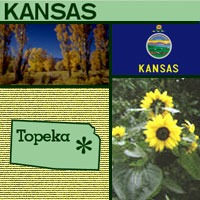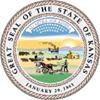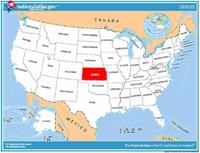|
Additional Lessons |
 About These
Lessons About These
Lessons
The following classroom lessons are great for students
who want additional listening and reading practice. |
-
Travel America -
Beginner
Level. Do you love America and American
English? Learn before you travel. Facts and other
cool stuff about your favorite U.S. state. Great
English reading practice.
|
 Travel
America - Kansas Travel
America - Kansas
(Beginner -
Reading)
Learn some interesting facts and read interesting
stories about Kansas. |
 Kansas Kansas
Known as the "Sunflower State," Kansas became the
34th state in 1861. The state's name comes from the
Kansa or Kaw Indians and is a Sioux Indian term
meaning "south wind people." Within Kansas's borders
is the magnetic center mark for all of North
America. All land surveys in the U.S., Canada, and
Mexico use this as a reference point. The geographic
center of the 48 contiguous (connected) states is
located in a Kansas pasture. The native sunflower is
the state flower and the capital is Topeka. |
Kansas
State Flag
The state flag of Kansas (adopted in 1927) features
the Kansas state seal on a field of dark blue.
Above the seal is the state crest; a sunflower (official
state flower of Kansas) resting on a twisted blue and gold
bar that represents the Louisiana Purchase (the original
Louisiana Purchase territory is now divided among 13
states). Beneath the state seal is the word KANSAS in yellow
capital letters.
Symbols on Kansas Seal
The symbols on the state seal of Kansas were specified by
the first Kansas legislature in 1861(the year Kansas became
one of the United States). All State Seals
The rising sun represents the east; the river and steamboat
are symbols of commerce; the cabin, and the settler and plow
horses represent agriculture as the base for the future
prosperity of the state of Kansas.
In the distance oxen draw a wagon train west, and a herd of
buffalo is pursued by two native Americans on horseback (the
American buffalo was adopted as the official state animal of
Kansas in 1955); herds of buffalo numbering in the millions
once roamed Kansas (correct name is "American bison").
In the sky are thirty-four stars (Kansas was the
thirty-fourth state admitted to the Union) with the state
motto above: "Ad astra per aspera "("To the stars through
difficulties"). |
|
Source:
State Symbols USA |
|
|
 Kansas
State Facts Kansas
State Facts
Picture: state seal of Kansas |
|
State Capital |
Topeka |
|
Nickname |
Sunflower State |
|
Motto |
Ad Astra per Aspera (To the stars through
difficulties) |
|
Statehood |
January 29, 1861 (34th) |
|
Origin of Name |
From the Sioux Indian for "south wind people." |
|
Largest Cities |
Wichita |
|
Border States |
Colorado, Missouri, Nebraska, Oklahoma |
|
Area |
81,823 sq. mi., 13th largest |
|
State Bird |
Western Meadowlark |
|
State Flower |
Sunflower |
|
State Tree |
Cottonwood (populus) |
|
State Song |
Home on the Range |
 Travel and tourism
site for Kansas - This state travel and territorial
tourism site provides ideas for your vacations, meetings, and more. Travel and tourism
site for Kansas - This state travel and territorial
tourism site provides ideas for your vacations, meetings, and more. |
|
|
Kansas Stories |
|
|
Lawrence City Band: Summer Concerts in the
Park
What's the oldest musical group you can think of that is still
performing? The Rolling Stones? Aerosmith?
The Lawrence City Band in Lawrence, Kansas, can trace its roots back
to the Civil War, a time when most of Lawrence's citizens were
originally from New England.
The band's first performance was presented on a beautiful summer
evening in 1863. As fate would have it, that was the night before
the legendary raid on Lawrence by William Clark Quantrill. Quantrill
-- and his men, who included the dangerous Frank and Jesse James --
was a murderer of Union sympathizers, many of whom were
abolitionists (people who were against slavery). Quantrill and his
450 Raiders attacked Union sympathizers, such as the people of
Lawrence. The Raiders killed more than 150 residents of Lawrence
during that raid, including all but one of the original members of
the Lawrence City Band.
Since then there have been many different members in the Lawrence
City Band as the group grows and shrinks depending on the number of
musicians in it. Today, the Lawrence City Band commemorates that
terrible day and continues the tradition of offering free music on
Wednesday nights during the summer to the citizens of Lawrence and
anyone else who travels there from far away. |
|
|
Medicine Lodge Peace Treaty
"The government of the United States desires peace, and its honor is
here pledged to keep it. The Indians desire peace and they now
pledge their honor to maintain it."
Those words were part of the Medicine Lodge Peace Treaty of 1867.
That treaty was drawn between the U.S. government and the five
tribes of Plains Indians -- the Cheyenne, Arapaho, Kiowa, Apache,
and Comanche in the city of Medicine Lodge in southern Kansas.
The Plains Indians had settled in Medicine Lodge, which, for them,
was a sacred area. The different tribes of Indians peacefully shared
a "lodge" on the banks of the river, which they believed had the
power to cure ills. This treaty allowed for white settlements in the
area, opened it up to railroads, and fixed the southern boundary of
Kansas.
Today, the treaty is celebrated every three years with a colorful
outdoor pageant re-enacting the events that led to the signing at
the place where the Medicine River and Elm Creek meet on the Kansas
prairie, now designated Memorial Peace Park. Events also include an
Intertribal Powwow featuring Native American dance competitions,
crafts, and food booths. The powwow is open to all tribes, with
special recognition given to the five Indian tribes that signed the
treaty. |
|
|
Community Life in Strawberry Hill
Do you know the expression "Every picture tells a story?" With the
paintings by Marijana Grisnik of Kansas City, Kansas, that is
definitely true.
Marijana Grisnik, a Croatian American born in 1936, captured
everyday life with her colorful paintings of the Strawberry Hill
neighborhood in Kansas City, Kansas. Strawberry Hill lies on the
bluffs overlooking the Kansas and Missouri rivers, and legend has it
that the name comes from the wild strawberries that once grew there.
Grisnik's work is influenced by the "naïve" artists of Croatia. The
"naïve" (pronounced nye-eve) style of painting is usually practiced
by someone who is self-taught and presents images in an
uncomplicated way. Do you think that is true in this painting?
The area of Strawberry Hill is most closely defined with the South
Slavic immigrants, especially the Croatians, who came in the late
19th century to seek greater opportunity and prosperity. As was the
case for many ethnic communities, life in Strawberry Hill at first
resembled life in the old country. Although many changes have
occurred, it remains a strong ethnic community and a center for
Croatian Americans throughout the Kansas City area. |
|
|
Little Sweden
Do you know who founded your city or town?
Lindsborg is a city in north central Kansas that was founded by
nearly 100 Swedish immigrants. Nicknamed "Little Sweden," this city
honors Lindsborg's Swedish settlers and cultural contributions.
Nestled in the Smoky Valley region of north central Kansas, the
community of Lindsborg was settled in 1869. The Swedish immigrants
who moved there were all followers of the Lutheran faith, which they
could not practice freely in their native land, and they also had a
great love of music. In the early days many of them were farmers.
Other Lindsborg founders were craftsmen, educators and musicians.
The Swedish immigrants had a passion for all things cultural, and
that attitude still exists today. A large number of artists and
musicians still live in Lindsborg, a community of approximately
3,200. Even now, the city has a Swedish character.
Are there any ethnic characteristics in your community that you can
trace to the area's beginnings? |
|
|
Wichita River Festival
Have you ever seen a bathtub race or a dinosaur raft? If you are in
Wichita, Kansas, during the River Festival in May, you will have
your chance. Every year Wichita celebrates with a 10-day-long party,
which was first held in 1972. In addition to the raft and bathtub
events, the festival features live entertainment, cook-offs, and a
fishing derby.
The Antique Bathtub Race, an event that is even recognized in the
Guinness Book of World Records, features antique tubs, mounted on
flotation platforms, all racing across water for the top trophy -- a
gold-plated bathtub. In the early days of the race, some of the tubs
never made it to the finish line. Some people suspect that there are
still a few tubs at the bottom of the Arkansas River!
During the Saturday morning raft race, decorated rafts float down
the winding Arkansas River, their occupants spraying the spectators
with river water. Besides the dinosaur raft, there have been race
car rafts, a Snoopy raft and a Dumbo raft. If you were to enter a
rafting contest, what would your raft look like? |
|
|
Tornadoes in Kansas
Kansas is known for many things -- wheat, sunflowers ... and
tornadoes! What famous story set in Kansas features a tornado?
The Wonderful Wizard of Oz, by L. Frank Baum, tells the story of
Dorothy, who gets caught in a Kansas tornado and lands in the
imaginary land of Oz. This story has been dramatized on stage and
film. You might have seen the movie version, which stars Judy
Garland as Dorothy.
Tornadoes are storms with rapidly rotating winds that form a funnel
cloud. Also known as "twisters," they extend downward from the huge
clouds of a severe thunderstorm. The winds that rotate within a
tornado usually reach a speed of almost 300 miles per hour! A
tornado often sweeps through an area quickly, but it can cause
considerable destruction. There have been a number of remarkable
reports of tornadoes. In one instance, a schoolhouse was demolished
while the 85 students originally inside it were carried more than
400 feet with none killed. There was also a case of five railway
coaches, each weighing 70 tons, lifted from their tracks. |
|
|
Neewollah
Spell "Neewollah" backwards and what do you get?
Halloween, of course! Neewollah first began as a fun alternative to
trick-or-treat vandalism. According to newspapers from 1918,
vandalism was especially bad that year, and Neewollah was created to
give kids a healthy option for their Halloween activities.
This event, held in Independence, Kansas, has grown from just a
Halloween night celebration to a festival that lasts nine days! It
features three parades, community theater musical productions such
as The Wizard of Oz, a talent show, and the coronation of a
Neewollah queen. Musical entertainment and games such as the
Neewollah medallion hunt add to the festivities. |
|
Source:
Library of Congress |
|
 Kansas Kansas
There are no national forests, parks, or
monuments in this state. |
|
|
|
 Travel
America Travel
America
Do you love America and American English? Learn before
you travel. Facts and other cool stuff about your
favorite U.S. state. Visit the Fun Easy English Travel
America pages. Read about the beautiful National
Forests, Parks, and Monuments. Great English reading practice. |
 Drive America Drive America
Planning to drive in America? Learn the rules and
regulations. Great English reading practice. |
|